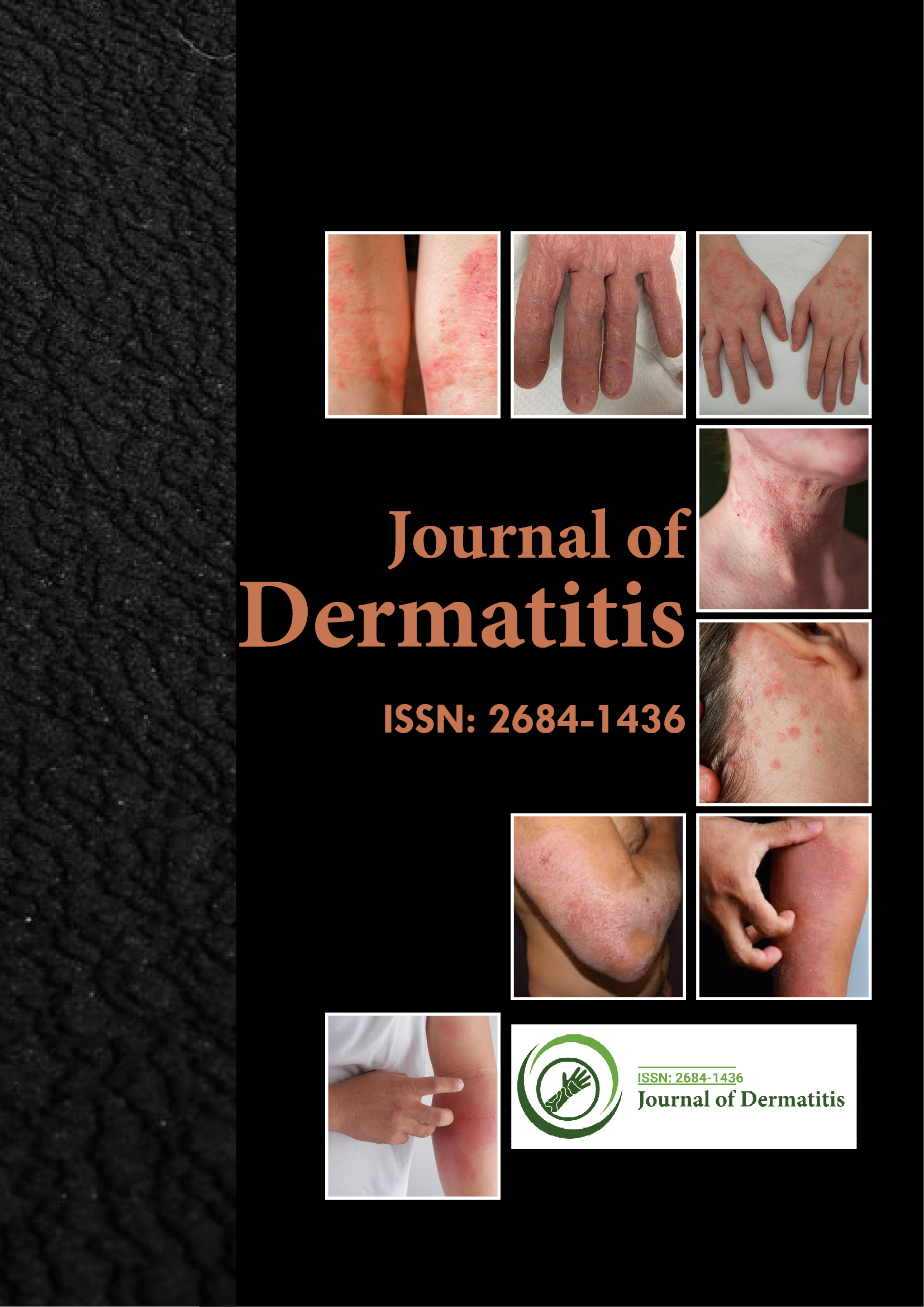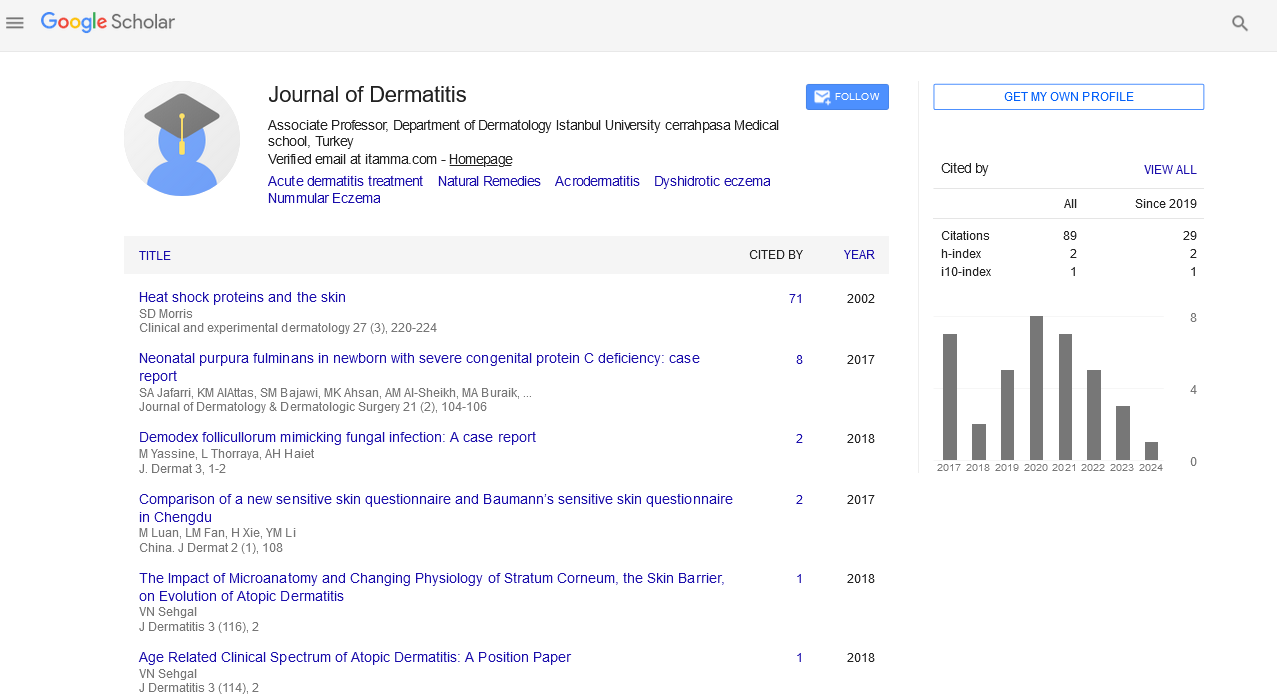Indexed In
- RefSeek
- Hamdard University
- EBSCO A-Z
- Euro Pub
- Google Scholar
Useful Links
Share This Page
Journal Flyer

Open Access Journals
- Agri and Aquaculture
- Biochemistry
- Bioinformatics & Systems Biology
- Business & Management
- Chemistry
- Clinical Sciences
- Engineering
- Food & Nutrition
- General Science
- Genetics & Molecular Biology
- Immunology & Microbiology
- Medical Sciences
- Neuroscience & Psychology
- Nursing & Health Care
- Pharmaceutical Sciences
Commentary - (2022) Volume 7, Issue 4
Treatment and Management of Nummular Dermatitis
Carolyn Robinson*Received: 01-Jul-2022, Manuscript No. JOD-22-17656; Editor assigned: 04-Jul-2022, Pre QC No. JOD-22-17656(PQ); Reviewed: 18-Jul-2022, QC No. JOD-22-17656; Revised: 25-Jul-2022, Manuscript No. JOD-22-17656(R); Published: 01-Aug-2022, DOI: 10.35248/2684-1436.22.7.158
Description
Nummular dermatitis or eczema is an inflammatory skin condition characterized by the presence of clearly defined roundto- oval erythematous plaques (nummular means round or "coin shaped"). In addition to describing the lesion morphology that can be seen in many different diseases, such as atopic dermatitis, contact dermatitis, and asteatotic eczema, the term nummular dermatitis has also been used to refer to a separate illness. The disease entity that has been discussed in the literature is the main subject of this discussion. Eczema with other names like discoid or orbicular has been used.
Deverigie first described nummular eczema as coin-shaped lesions on the upper extremities in 1857. Since then, it has been reported in all age groups and on all body parts, but the upper and lower extremities are where it is most frequently found. Papules-which typically develop into plaques—are the precursors to lesions. They frequently have scales. Vesicles containing serous exudate might be scattered throughout early lesions. Nummular eczema frequently causes intense itching. Numerous precipitating factors, such as dry skin, contact allergies, weather (particularly winter), nutritional problems, and emotional stress, have been identified.
The most crucial element in treating nummular eczema is skin hydration. The first step in therapy is to use hypoallergenic, fragrance-free creams, lotions, or ointments. Rehydrating the skin, repairing the epidermal lipid barrier, reducing inflammation, and treating any infections are the main goals of treatment. The best way to absorb emollients and medications is to dampen the skin first.
Baths or showers that are lukewarm or cool help to soothe itching and rehydrate the skin; People can use a mild soap or liquid cleanser. Moisturizers should be applied to still-damp skin after the skin has been patted dry. The "soak-and-smear" therapeutic regimen calls for a nightly 20-minute soak in plain water, followed by the application of petrolatum or steroid ointment to wet skin. It also calls for changing one's cleaning routine to limit the use of soap to the axilla and groyne. In one study, when the regimen was adhered to as instructed, 27 of 28 patients with refractory chronic pruritic eruptions showed greater than 90%response.
The use of wet wraps is frequently beneficial. To do this, wet the skin with lukewarm water until it is sufficiently hydrated (usually 10 min). Next, liberal amounts of petrolatum or steroid ointment are applied, and then the patient is enclosed for one hour in damp pyjamas or a non-breathable sauna suit. Plastic wrap can be applied to occlude small involvement areas. Petrolatum can be used to repeat this procedure 5–6 times per day. When using prescription steroid medications, caution must be exercised because excessive use of these drugs can result in stride, skin thinning, and, in rare cases, enough systemic steroid absorption to affect the hypothalamic-pituitary-adrenal axis.
The most popular form of treatment for inflammation reduction is steroids. Low-potency (class III-VI) steroids can be used to treat less erythematous, less itchy lesions. High-potency (class I-II) preparations are needed for severely inflamed lesions with intense erythema, vesicles, and pruritus. Occlusion and/or presoaking in a tub of plain water, followed by the application of the steroid-containing ointment right away (without drying), increase the medication's ability to penetrate the skin.
Because they are more occlusive, create a barrier between the skin and the outside environment, and better hold water in the skin, ointments are typically more effective than creams. Patients may, however, be more likely to use a cream formulation; patient compliance is largely dependent on education and conversation. In cases of severe, widespread eruptions, steroids may be administered orally, intramuscularly, or intravenously. Particularly in older, thickened, scaly plaques, tar preparations are useful for reducing inflammation.
Tacrolimus and pimecrolimus, topical immune modulators, also lessen inflammation. To lessen the possibility of a burning sensation when applied to extremely irritated skin, these are frequently started a few days after the topical steroid. Although there isn't much information on nummular eczema specifically, the topical agent crisaborole, which is approved for atopic dermatitis, may also be helpful. Skin that has been aggressively moisturised may experience fewer outbreaks of nummular dermatitis.
Bathing is acceptable, but people should avoid using hot water. Use gentle, nondrying cleansers on patients. Encourage patients to only use non-soap cleansers to control body odour and maintain cleanliness (eg, on the groin, axillae, and feet). Bathing water may contain oil additives. After bathing, use an emollient right away to prevent drying out of the lesions. Before the skin is completely dry, it can be patted and the emollient applied. To prevent overheating, clothing should be loose and itchy fabrics like wool should be avoided. Particularly when a heater or air conditioner is being used, a room humidifier is beneficial.
Citation: Robinson C (2022) Treatment and Management of Nummular Dermatitis. J Dermatitis.7:158.
Copyright: © 2022 Robinson C. This is an open-access article distributed under the terms of the creative commons attribution license which permits unrestricted use, distribution and reproduction in any medium, provided the original author and source are credited.

